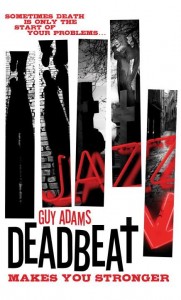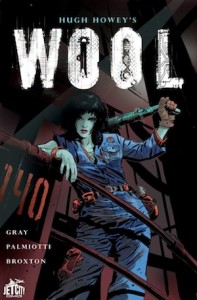“The Engine would smell like a mix of diesel fuel, old leather and bay rum” Jimmy Broxton and Guy Adams discuss Madefire’s The Engine and the smell of motion books

The book is not what you expect when you see a cover with a giant robot on it, how important was it for you to subvert people’s expectations and create something more intellectually challenging that just another book about a big powerful robot?
JB: Subverting people’s expectations is my goal in life.
GA: I knew you were going to say that.
JB: …whether I’m able to achieve this in an intellectually stimulating way is very much open to debate, a short debate I imagine.
GA: The Engine is very varied. As it goes on you’ll see a real mixture of stories, from brash, in-your-face action to lighter, even comedic moments. Those are the sorts of stories I like, those that keep changing and pulling the reader along. Life isn’t one thing or another after all.
Tell us a about the process of creating a motion book for Madefire? How does the process manifest itself, is it like traditional comics or is there more back and forth between the writer and artist and other? What do you like and dislike about the process?
JB: The process is exactly the same in terms of communication with the writer as it would be on a regular comic, as in, Guy writes a script, and then I draw it (obviously if I need clarification on anything, I just ask), because he has a very visual sense, everything I need is there to get me started, his scripts flow beautifully, importantly though he doesn’t try and impose his vision, by which I mean, camera angles, descriptions for staging and set up, panel arrangements and so on. That is the artists job, to make a comparison with film, the artist is the director, not the writer, and they have no business directing artists in this way, (just as artists have no business telling writers how to spell properly or construct sentences). I realise some writer’s do not share this view, and will try and call the shots visually, it must be very frustrating for them, I feel their pain. The technical aspects of creating the art is quite different however, more like animation, with multi-layered panels, with discreet figures, masks, and completed backgrounds behind figures, it’s more time consuming, but essential to allow for the Madefire effects.
GA: I will say, the reason I don’t feel the need to impose my vision on Jimmy is because I don’t have to! He gets it. I think a writer has to vary in how much input they give on that side of things. Jimmy is very collaborative and a great storyteller, which I love, comics should be an extremely collaborative medium.
That said, some artists actually like more direction and would look at the scripts I write for Jimmy and think I was being a terribly lazy writer.
It’s all about communication and establishing a rapport. Jimmy and I get on well both on the page and off it, we tell stories well together. That’s a real pleasure.
You use a nice range of smart transitions as well as some great use of sound to give the book a dynamic feel, but how do you balance what you think is right for the reader to make for an enjoyable reading experience? Do you know where to draw the line or are you happy to keep pushing the boundaries?
JB: Madefire do all of that stuff themselves, I get the impression though, that pushing the boundaries is definitely the name of the game.
GA: I play the balalaika throughout.
That’s a lie.
As Jimmy says, that part of it really is down to Madefire.
For those who’ve not seen your work before tell us what other books we should be checking out and how did you two meet and come to collaborate?
JB: I’m fairly new to comics, so there isn’t much out there, I did issue 6 of Paul Cornell’s: Saucer Country, collected in the Run graphic novel from DC Vertigo, I also drew: “Pornland Oregon” for the “Sex and Violence” graphic novel from Paper Films by the unstoppable writing powerhouse of Jimmy Palmiotti and Justin Gray.

GA: We met through The Engine, love blossomed across the icy tundra.
JB: Yes it’s true, not even a permafrost could cool our creative flames, we have the Engine, and we’ll always have Omsk.
GA: If I’m known at all, I’m really only known for prose at the moment. Novels like The World House, the Deadbeat series, the Heaven’s Gate books. I’ve also written some Sherlock Holmes novels and adaptations of old Hammer Horror movies. Lots and lots of books.
Additionally, what can we look forward to from The Engine next? What else are you working on at the moment – any plans for other motion books?
 JB: No plans for any other motion books right now, but In addition to my work with Guy on The Engine, we also have Goldtiger, to be released next year, our comic strip love letter to the swinging 60s, that is never quite what it seems, and most definitely subverts expectations. I’m also working with the brilliant Paul Cornell once more on his Doctor Who “one shot”: “The girl who loved Doctor Who”, out in Dec from IDW and Justin Gray and Jimmy Palmiotti have brought me in to help adapt Hugh Howey’s: “WOOL” for the newly launched Jet City comics from Amazon, to be serialized in digital from, with a collected print edition next year, I’m incredibly lucky to be working with some amazing people right now on projects that I couldn’t be more excited about.
JB: No plans for any other motion books right now, but In addition to my work with Guy on The Engine, we also have Goldtiger, to be released next year, our comic strip love letter to the swinging 60s, that is never quite what it seems, and most definitely subverts expectations. I’m also working with the brilliant Paul Cornell once more on his Doctor Who “one shot”: “The girl who loved Doctor Who”, out in Dec from IDW and Justin Gray and Jimmy Palmiotti have brought me in to help adapt Hugh Howey’s: “WOOL” for the newly launched Jet City comics from Amazon, to be serialized in digital from, with a collected print edition next year, I’m incredibly lucky to be working with some amazing people right now on projects that I couldn’t be more excited about.

GA: I have a new novel out in a couple of weeks, the first in a new series from Del Rey UK called The Clown Service. That’s a fun mixture of espionage and horror.
In comics, I’ve reinvented an old 2000AD character called Ulysses Sweet – Maniac for Hire, that’s starting in December alongside some other bits and bobs for them.
Comics are where I’m trying to expand at the moment. I have three different novel series running with three different publishers, in the gaps between work on those I’m finally getting to work in the medium that was my first love and I can only hope it will continue.
The Engine #1-5 is available via the free to download Madefire app. For more information on Jimmy and Guy then follow them on Twitter @jimmybrox and @guyadamsauthor


